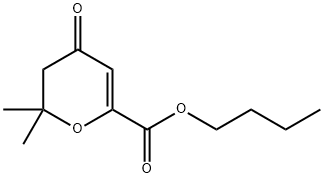To a 25-mL flflame-dried flflask under a nitrogen atmosphere were added freshly distilled Rawal’s diene (227 mg, 1 mmol, 1.0 equivalents) and 2 mL of CHCl3. Benzaldehyde (1.5 mmol, 1.5 equivalents) was added dropwise via a gas-tight syringe. The reaction mixture was stirred at room temperature for 2 h and then diluted with 15 mL of CH2Cl2. The yellow solution was cooled to −78 °C and treated with 142 µL acetyl chloride (2 mmol, 2 equivalents). After stirring for about 30 min, saturated Na2CO3 was added. The organic layer was separated and the water phase was diluted with 15 mL of water and extracted twice with CH2Cl2. The combined organic phase was dried with MgSO4, fifiltered, and concentrated to give a yellow oil, which was subjected to flflash chromatography to afford the desired dihydropyrone in 86% overall yield. Reference: Huang, Y.; Rawal, V. H. Org. Lett. 2000, 2, 3321−3322.
Yellow to pale reddish-brown liquid;
aromatic odor. Reasonably stable in air. Slowly
affected by light. Insoluble in water; miscible with alcohol,
chloroform, ether, glacial acetic acid.
Indalon is an insect repellent.
Insect repellents that can be applied directly on the skin.
ChEBI: Butopyronoxyl is a member of pyrans and a carbonyl compound.
Butopyronoxyl is not water soluble and can be applied to skin and clothing to repel
biting stable flies, Lone Star ticks, dog and cat fleas, and chiggers.
Toxic by ingestion. May cause liver dam-
age.
Moderately toxic by
ingestion. Produces liver necrosis in
experimental animals. A rmld skin irritant.
See also OXALATES and ESTERS.
Combustible when exposed to heat or
flame. When heated to decomposition it
emits acrid fumes.
